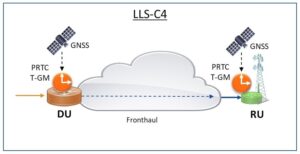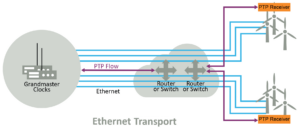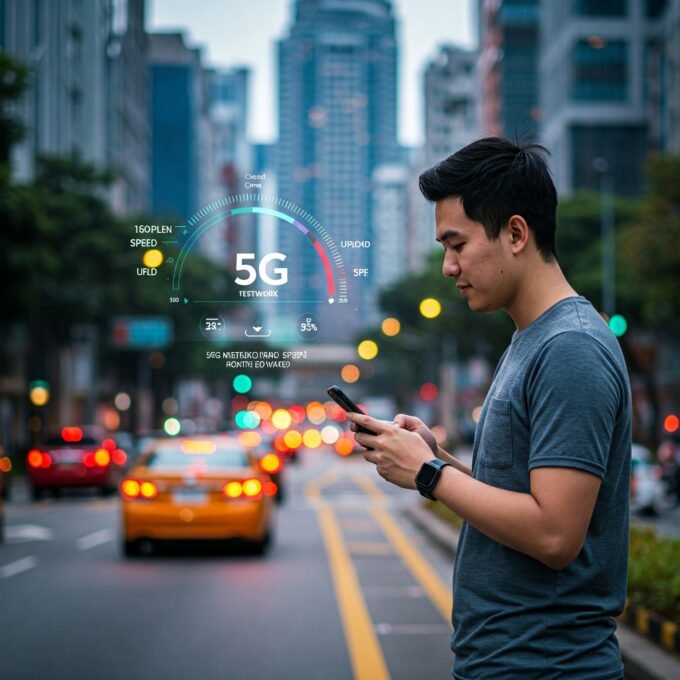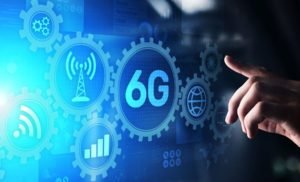Did you know that GPS, the technology that provides location and timing information, was invented in 1973, the same year as Ethernet? Since then, GPS has made significant progress, and now it can locate smartphones within 4.9 meters, which is much better than the 100 meters accuracy experienced in 1994. Additionally, its timing has improved from milliseconds to less than 30 nanoseconds, and it is expected to continue improving to sub-nanosecond levels.
In the video, we spoke with Microchip’s David Chandler and Duke Buckner, who provided insight into the status of GPS and where it’s going over the next five to ten years. An edited transcript of the conversation follows. Click here for links to EE World’s collection of articles about network timing and synchronization, which includes several on how GPS plays a role.
EE World: We’re here to talk about the 50th anniversary of GPS and interestingly enough, 1973 was also the inaugural year of another technology that we use very much called Ethernet. Both technologies are very much a part of our lives. David, I wonder if you could give me an overview of, not so much the beginnings of GPS. I think anyone can find that online. How has GPS progressed over the years and where is it today?
Chandler: Sure, I’m happy to. I can give you a personal experience when I was in the Army in 1994. In Saudi Arabia, our Patriot radar systems had GPS at that point and to try to position where the radars were, and it was incredibly painfully slow, we had one or two satellites, maybe three back then and then in 1994. You get, if you’re lucky, 100 meters. We were still doing things with plumb bobs better than we could with GPS in 1994. Fast forward to today, and there are solutions out there. GPS, in and of itself, we’re starting to get, without any other additional aid, you’re getting, sub meter down to centimeter-type levels, 10 centimeter type level precision now. It’s really changed the way the world works, from anything from, how do I wind up getting from A to B, to actually your timing, this communication that we’re talking about right now would not be possible without GPS, if we weren’t synchronized.
EE World: So does the improvement, the improvements come from upgrades to the satellites, new satellites, or the technology on the ground or a combination?
Chandler: It’s really all the above. We’ve been improving the accuracy of the satellites. There has been three different blocks of GPS today. As those have progressed, there has been improvements in the timing on the satellites. You’ve been seeing improvements and the algorithms that are used to steer them, just in terms of what UTC is. Steering to GPS time has been another thing that’s been improved, but also on the ground level, the user levels, the receivers have just gotten much, much more precise. The technology is advanced, if you looked at our first GPS receivers, you’d have these big, clunky handheld receivers, if you were lucky, you could fit them in that now the technology is sitting in our phone as an afterthought. It’s really been both sides of the equation have improved drastically.
EE World: How many GPS satellites are there? And are they low Earth orbit? Mid Earth orbit? Where are they?
Chandler: So they’re geosynchronous? Actually, I’m not sure in actual total quality. Do you know the quantity that’s flying right now?
03:38
Buckner: 31 base vehicles. They’re all in mid-Earth orbit. We get global coverage 24 hours a day, seven days a week. We all greatly depend on those things moving around.
EE World: Well, we certainly do. Thank you. Thank you, Duke for letting us know about that. So timing is a big deal. I mean, we all get time from GPS. Can you tell us a little bit more about other than getting, you know, the time of day? What does GPS do? And how does the timing of GPS help systems on Earth?
Chandler: I’ll go right to the position equation first. The amount of time it takes a signal to get from the satellites down to your individual position. The signal travels at the speed of light. So when you know how long it takes each one of the satellites that you’re seeing you get down to your individual position. You can use some geometry and figure out your position precisely and it’s really all just a time equation, right? You’re saying I know where those satellites were supposed to be at this time of day, I can see how long a signal took to get to me, and hence I can tell exactly where I am. On the simplest level, that’s what it was designed for the military really way back when.
Also read: Improving Signal Integrity By Considering Trace Roughness, Glass Weave, And Stackup Effects.
Now it’s just so much more things like 5G systems have to be synchronized, right? To get your package at the right time, things like that, you really have to have everything synchronized. If you look in data centers today, they have to worry about synchronizing, they’re trying to transact data, multiple different data centers, right, multiple replications are trying to pull all that together as one single virtual database. In order to do that, they have to have a good reference time in each location. So another example of using GPS.
There are lots more things as you look at the time, there’s lots of industrial applications today, if you look at our critical infrastructures and other area, multiple different areas, that power grid has to be synchronized today, because we have these alternate power sources coming in. You actually have to very carefully manage the load now from renewable sources versus conventional sources that we used to have.
EE World: What generates the time on the satellites? How do the satellites know what time it is?
Chandler: The way the satellites know what time and it’s a couple of different things going on. First of all, we have USNO in Washington, DC, that is our primary time reference for the GPS system. That time is actually what we call an ensemble, which is a number of different atomic clocks, essentially, all put together. You’re comparing them all against each other. We have hydrogen masers, we have cesium beam tubes, we have lots of different types at us now, as well as some more elaborate, I’ll say, laboratory type pieces of equipment. USNO ensembles, this. They come out with one specific time base time tick from USNO that’s our official GPS time for the world. If you drive by the United States Naval Observatory, you can actually see that time on an LED display.
That time is compared to global international time, called UTC Universal Coordinated Time, which is on top of USNO. You have all these other locations. You have NIST in Colorado, you have PTB Germany, you have lots of different locations around the world that contribute their atomic clocks into this ensemble, tell us what the time is. So you have that on the ground.
Then we have this official time tick coming out of USA now. What happens then is that time tick is sent to the ground stations, and relayed up to the satellites. Now the satellites are spinning around the earth. And those satellites, they get the time signal, and then they have to maintain it until they get their next time base. So the satellites either have cesium or rubidium clocks on them that essentially have to maintain the time accuracy they’re getting from the ground stations until the next time they get an update. So that’s really those atomic clocks are not as precise as the ones on the ground but they’re still very stable products. At Microchip, we have several of them up there today operating continuously on those satellites.
EE World: Microchip has contributed a number of articles to EE World on timing, specifically towards 5G. Let’s look at that a little bit. Many 5G equipment, telecoms they have they will have their networks synchronized to GPS and sometimes the signal gets lost. That’s part of what some of the timing devices have to deal with. Can you explain that a little bit about what what happens if you sure lose contact with the satellite?M
Chandler: First of all, one of the reasons why we would lose a satellite you know, people ask questions about why if we have GPS, why do we have to worry about it? Well, we worry about it. For there’s both naturally occurring things like solar flares, or it could be if I’m traveling and going under a tunnel, the signal can’t get through that. But I can also have the situation where there’s nefarious actors out there intentionally trying to jam GPS, it’s [an] inherently a low signal. When we gets it on Earth, it doesn’t take much to jam it. And more advanced operators can in fact spoof it, which makes it looks like they’re doing it. So if we are jammed, for whatever reason, whether it’s benign or nefarious, when we have jamming, we’ve got to come up with some way of providing that time.
What we do is we use atomic clocks, maybe quartz-crystal oscillators as well, as backups, essentially, what we do when the signal is there, and it’s healthy, we steer these clocks to the signal coming off of GPS, so they know what time of day it is.
 They also know how much they’re different from it. So, they get a time coming down from GPS constantly, they’re also providing their own time, that quartz oscillator might be vibrating at 10 MHz, or, you know, an atomic clock might be sitting there operating away at nine GHz. Whatever is going on, we compare the performance of that clock on the ground, and how it’s drifting, to GPS. Then when GPS goes down, if it’s detected, that it’s down, or it’s detected, that it’s spoofed, we essentially have these slightly lower grade clocks than GPS that are going to remember what they did in comparison to GPS, and they’re going to make their best estimate.
They also know how much they’re different from it. So, they get a time coming down from GPS constantly, they’re also providing their own time, that quartz oscillator might be vibrating at 10 MHz, or, you know, an atomic clock might be sitting there operating away at nine GHz. Whatever is going on, we compare the performance of that clock on the ground, and how it’s drifting, to GPS. Then when GPS goes down, if it’s detected, that it’s down, or it’s detected, that it’s spoofed, we essentially have these slightly lower grade clocks than GPS that are going to remember what they did in comparison to GPS, and they’re going to make their best estimate.
Then based off their own clock, plus a conversion rate that they got from that error, while they were tracking the whole time. And that’s how we move along until we have GPS coming back. Again, it depends on a 5G network, you actually have atomic clocks, that are very, very stable. Our cesium references that are individual clocks. There might be able to operate for; there’s a new specification coming out from ITU that we’re talking about 40 days holdover, having a total of 100 nanoseconds now stability over 40 days, which is really incredible. That’s for the extreme “Cadillac” version of what you could do.
If you look back at something more like maybe you have someone who’s got an individual cellphone tower someplace, that individual receiver is not going to be able to do. It’s not economical, but that level of atomic clock at each individual tower. The tower might have a quartz crystal oscillator that maybe can do something like one microsecond, for 24 hours is a common goal. Of course, couldn’t do that on its own. Unless it was learning when it was actually on GPS. Error corrections are then used with the quartz to try to get us into that one microsecond region.
Also read; KYOCERA AVX Introduces A-Series Low-Profile Automotive Antennas At CES 2024
EE World: Once you’ve got this time, and let’s say let’s you’ve got connection to GPS. How is that time then distributed to different parts of the network to keep them synchronized? If you’ve got your reference, that’s great. But you now have to get everything else synchronized. So that again, so that data arrives, when you expect it. How does that synchronization work?
 Chandler: The most common way that systems are synchronized today in a 5G network is through something called Precision Time Protocol, PTP, which is also known as IEEE 1588, which is a standard. Basically, that is timing over packets or timing over Ethernet.
Chandler: The most common way that systems are synchronized today in a 5G network is through something called Precision Time Protocol, PTP, which is also known as IEEE 1588, which is a standard. Basically, that is timing over packets or timing over Ethernet.
What we do is we send a message out from where the GPS receiver is to the other locations, packet-based signals that go back and forth. What happens is you have kind of this time difference, time of arrival thing will send a stamp out saying, “here at the GPS station, I know it’s time.” That is received further downstream, where they say, “Okay, I receive time A, and I see it as time B.” Then they send a Ethernet signal back that says time D, “I saw your time is this time here, and eventually, through some simple math, talking back and forth over the Ethernet, you can get the precision [to be] very accurate. Below at least the tens of nanoseconds right now is what were retrieved PTP in some applications.
EE World: Is that synchronization or is that timing in general ever good enough? Do we always need to get a little better? Where do you see GPS and then synchronization going in the next several years? I’ve been involved in a number of conferences that talk about 6G. Nobody’s brought up synchronization yet but at some point, when we get far enough down the line that the specifications start coming together, timing will become part of that. Where do you see timing, accuracy, and precision going in the next five to 10 years?
Chandler: There’s a push to get us below one nanosecond. Some of those applications are getting to that sub-nanosecond technology. They talk about things like having doctors operating on you remotely. Clearly, you want his time to be as real as possible as to what he’s doing. That may not actually be the best case of why you need nanoseconds because he can’t respond in seconds. His neurons aren’t going to respond that quickly, but it still gives you an idea of the critical applications that are coming.
Will timing ever be good enough? It’s a common question [that I] don’t think will reach an answer. Technology is always moving forward.
I think there were lots of people who said back in 1970s, when we had Network Time Protocol [and people said] “oh, my gosh, you know, I have one millisecond, who the heck is really going to need one millisecond?” We develop the technology [and] the applications are finding it. I think we’ll continue to see that push, I think we’ll start seeing sub-nanosecond solutions being more readily available.
There are some boutique solutions, I would say now that national physics labs may be able to communicate amongst themselves in sub=nanosecond precision. I think you’ll see that more readily available to public applications or private applications within the next five to ten years.
GPS, they just released some of the newer technology there, um, code, you know, they’ll be a block for something, I don’t know if that’s going to be five to 10 years, to be honest. I think what you will see, though, is actually somewhat of how can we supplement GPS? I think there’s going to be a lot more focus on these alternate solutions, to both provide situations to provide timing and positioning when GPS is out. Also to improve the precision as well, in some cases. I think that’s really going to be the focus in the next five to ten years in the satellite-based timing world.
EE World: There’s a lot of talk amongst the people trying to figure out what 6G should be, and looking at what are the things they look at is to say, “Okay, we have all of these various features.” And I’ll say, in 5G, there’s a whole talk about low latency and 5G. Then as soon as you say, “Okay, we have this low latency,” somebody says, “It’s not good enough.” There’s a lot of talk about how to improve the synchronization in 6G to be able to allow for applications that won’t even be able to be done in 5g. So there’s a lot of that going on. And that’s gonna all play into the specifications as they come out, which will be you know, in the over the next, you know, five years or so. What is microchips role in all of this? In terms just in terms of the in terms of 5G? Let’s stick with that. What’s Microchip’s role in terms of GPS, 5G, and other timing situations?
Chandler: We sit on a number of different standards boards, so we help steer the industry as to what’s possible. What we can do best is the timing. That’s not just our clocks, our atomic clocks, or our quartz crystal oscillators. It’s also our network synchronization capabilities. Some of the PTP systems that I was describing. We sit on a lot of these industry boards to help steer what can be done and we also hear what the users applications are trying to figure out what the next solution is. So we’re we’re there. We’re helping the industry define what can be done.
We’re also hearing what they need to be done and coming up with newer solutions. We’re working on high-accuracy PTP solutions today that are moving maybe order two orders of magnitude improvement on what we offer with our standard stuff today. That’s anywhere from the distribution to repeaters, relay stations, all these different areas are what we’re contributing in the 6G GPS. We’re heavily involved with some newer projects coming out, that are based on alternate solutions: alternate timings where we’re talking to a lot of these people. At a minimum, they know they still need their accurate time basis, and we’re coming up with newer atomic clocks in the future that will be smaller in terms of weight and power. That will provide people [with] some capabilities that are out there today.
EE World: David Chandler, and Duke Buckner, thank you for taking the time to speak with us today.














Leave a comment